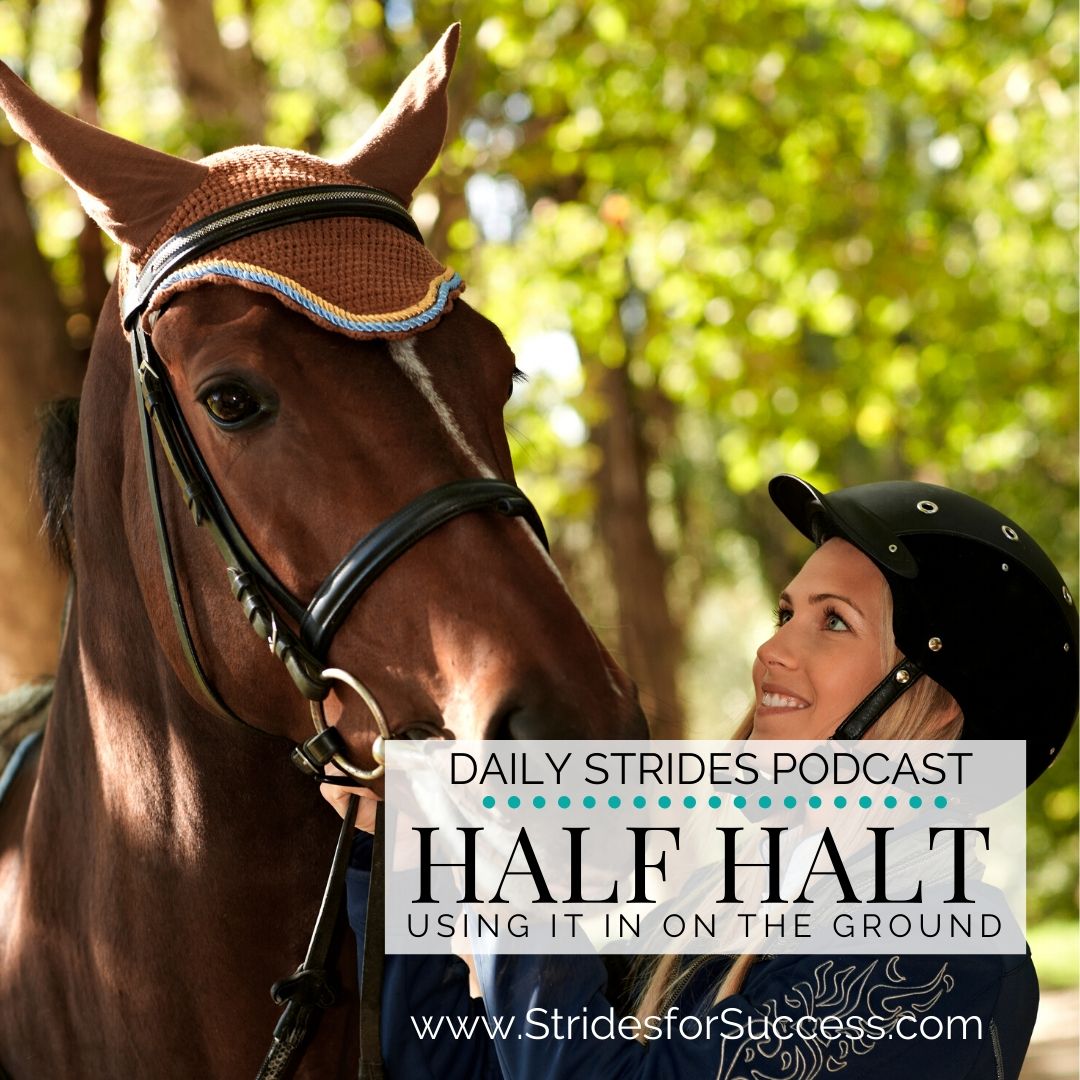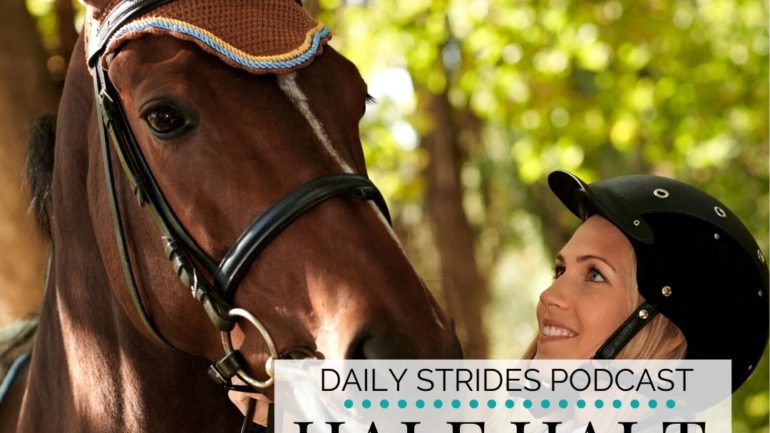
Sprinkled liberally all over the arena and every ride. That is how important the half halt is to your riding. However, it is also an important aid on the ground with your horse. And, it consciously practicing it on the ground can really help to clarify the aid for you, as a rider.
So many riders think that the half halt is only for the saddle. It is an aid that exclusively happens when communication is coming from above with regards to their horse.
However, I am a huge believer in groundwork and in how practicing the half halt on the ground will help your overall riding efforts going forward on your journey as an equestrian.
The Half Halt Helps You
Working on the half halt ion the ground is a great place to begin being more mindful about how you are showing up for the overall conversation with your horse. Be honest, how much of your interactions with your horse on a daily basis are just routine? Autopilot? No thought, you just do it?
Autopilot is great for certain aspects of your riding. The conversation with your horse is not one of those things!
Noticing and working on improving the half halt on the ground is a great way to begin taking the ‘day to day’ off of autopilot. Doing this has the potential to change the whole conversation, as you will see where the boundaries truly are. You will also see where you might just be allowing a lack of consistency to be the only thing that is truly consistent in your riding!
Begin Beside Your Horse
If I was to ask you to list the aids you use when trying to get your point across to your horse, what would that list look like? 3 or 4 aids? 10 or 12 aids? There are lots of aids at your disposal. Lots of different ways, both natural and artificial, you can use to explain what you want to your horse.
But listing and using the aids are two different things. Next time you lead your horse, notice how many of those aids you are actually using.
Start by simply walking your horse up and down the yard. How are you asking him to walk on? What are you doing when there is a turn or corner? And stopping him? What are you doing then? You see, often we know what we can potentially use and do, but knowing and doing are different!
Your mind will always look for ways to make things as easy as possible for you and your body. Unfortunately, often where horses are concerned, the easiest thing might not necessarily be the best thing.
Using Your Aids on the Ground
The most obvious aid for many riders is the hand aids. As you lead your horse, you will hold either the reins from the bridle or the lead rope attached to the headcollar or halter. Your hands will, therefore, play a part in the overall balance of your aids when it comes to leading your horse around.
Just like riding, how big a part your hand aids play will depend on your skills. Less skilled usually means they have a greater role in the communication
The more skilled you are, the more that you will notice how your other aids make up a bigger part of the communication. Your voice and position. Body language. Even ‘weight’ can be used to communicate with your horse. Obviously these are more subtle aids.
And just like in the saddle, the more subtle aids can only begin to be effective when we ‘quiet’ our more obvious ones. When we begin to become mindful of our own actions and the consistency of those actions.
Ask for Halt; Mindfully This Time
So all that being said, I want you to again, lead your horse up and down the yard. Except for this time, you are going to really begin noticing your aids. The simplest way of doing this is to ask your horse to halt. What is the process that physically happens in your body from the point that you think ‘I want to halt’ to the point where your horse actually halts?
As I said, you will probably notice your hands play a role. Remember, even when your aids are refined to the point where the balance has shifted, your hands are still an aid. They remain an important part of the conversation. I feel that many riders want to ‘delete’ or ‘get rid of’ their hand aids. Why? If used with consideration and kindness, they can be a great way of explaining and clarifying things with your horse.
You might notice your voice. The tone rather than the words. A slow, low tone ‘whoa’ goes a long way when used consistently at just the right time.
Your position is also important and a pretty easy one to notice. I speak a lot about the importance of position for good, clear communication. This is whether you are in the saddle or on the ground. Think about how you can use where you are standing in relation to your horse in order to communicate ‘stop’ or ‘go’. If that is too big of a challenge, think about slow down or speed up.
Your body language is also a very powerful aid when working on the ground. For example, your shoulders are a simple way to ‘close a door’ or ‘open a door’
Your Most Important Aid?
I do think that there is one aid that is above all of the others; and it is the one we have been chatting about from the start of this post. Your thoughts. In order to refine or effectively use any of your other aids, your thoughts are going to have to be clear about what you want to happen. And how you are going to make it happen.
Observe yourself. Look at how your actions are all happening because of whatever it is you are (or are not) thinking. So it makes sense to work on controlling what your thinking, in order to control what you are doing, doesn’t it?
What do I want my horse to do? How can I best tell him that is what I want him to do? And how can I then tell him that ‘Yes, that is what I wanted’ after he has done it? These are all thoughts. However, so often we either forget to ask ourselves these questions. Or we ignore the answers…
The communication with your horse will improve when you start asking yourself better questions, and then responding to the answers of those questions with more consistent actions (or aids)
Working on the Half Halt
There is an important word in the sentence; half. It is not a halt. No stopping, either physically or mentally, must occur. The half halt is rather a way of getting your horses attention. A way of telling him to focus on you, because you need to communicate something important to him. What you then communicate depends on you. It could be steady up. Or slow down. Maybe that you’re turning a corner or bend. Or stopping.
The important thing is to recognize the difference between how you communicate your intention for either movement to your horse. Halt or half halt.
With the half halt, you have to first actively engage the forwardness. I’m using the word ‘engage’ here as a mental word. You are noticing and emphasizing the ‘forwardness’. There are many ways to do this using your aids and it is key to recognize that only by ‘playing’ with your horse, will you really begin to understand what your horse resonates with.
Does your horse respond well to your body language? A click with your voice? Maybe a simple shift with your position. Or maybe an artificial aid is the best right now to clarify what you want?
This Week with Your Horse
I want you to begin playing with your aids. Experiment. See what happens when you:-
1. Ask yourself better questions
2. Become more mindful about noticing your answers
3. Be consistent with how you take action on those answers
There are so many aids you can use when working with your horse. I have just spoken about a few that you can use today. However, I want you to begin playing with them and others.
I am also going to invite you to join me for a free live workshop all about your half halt on the ground. If you’re interested in learning more and potentially joining me for an hour where you will walk away knowing exactly what to do; register for the live training HERE
Happy Groundwork!
Lorna
Additional Resources to Help with This Topic:-
-
-
- Understanding the Balance of Your AIds
- Groundwork; The Bookends to Your Riding
- Groundwork for Riding
- Communicate with Your Horse through Groundwork – Part 1 Touch
- Communicate with Your Horse Through Groundwork – Part 2 Pressure & Release
- The Daily Strides Podcast on iTunes
- The Daily Strides Podcast on Stitcher Radio
- Join Daily Strides Premium
-

